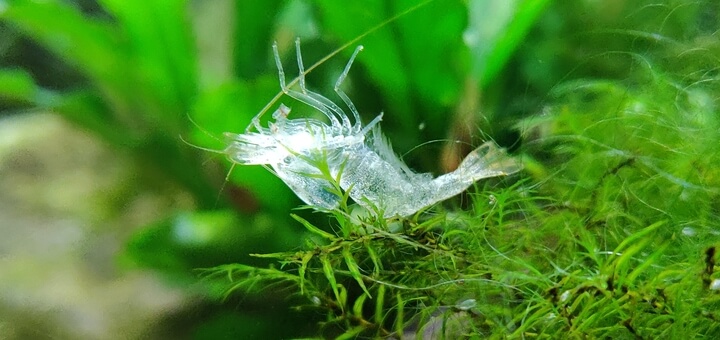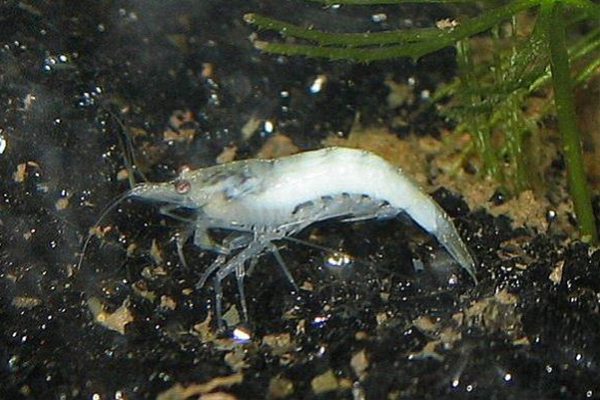Shrimps can be a lovely addition to any tank, due to their variety of beautiful, vibrant colors. Since they’re invertebrates, it means that they are covered by an exoskeleton that they use to protect themselves. As their bodies grow, they need bigger and bigger exoskeletons, which is why they have to go through the process of molting.
So, maybe you’re wondering, is my shrimp molting or dead? Actually, it depends on what they look like. An empty-looking shell that seems to have blown up is likely a shrimp that has molted, while a pale white body that turns pinkish within a day or two is likely a dead shrimp.
If that sounds confusing, don’t worry! We’ll discuss below how to tell the difference between a dying shrimp and a molting shrimp.
Table of Contents
Why do shrimp molt?

As mentioned above, shrimps are invertebrates that use an exoskeleton to protect their soft bodies from external factors.
In the case of shrimps, in particular, their exoskeletons are in the form of a shell, which acts as a hard protective covering. While this is all good, it’s not very flexible in terms of growth. Due to their hardness, the shells can’t expand to fit the bigger bodies of growing shrimps.
This is where molting comes in. During molting, the shrimp will pop out of its tight-fitting shell and spend the next few days growing a bigger, roomier shell. This new shell will eventually harden, allowing the shrimp to come out again until the next molting session.
If the conditions of your tank are alright, shrimps should molt once every 1-4 weeks, depending on their age. Younger shrimps typically molt weekly or biweekly, while adult shrimps only need to molt once every 3-4 weeks. The water conditions need to be consistent during this time, as shrimps are rather fragile and vulnerable in the time between their molt and their new shell.
One exception is female shrimps, who need to molt before any breeding can take place. As she leaves her shell, the female shrimp will release a pheromone for the males around. This will signal the start of their mating.
Is my shrimp dying or molting?

Although many aquarists don’t see the full molting process, there are some signs that you can use to determine whether your shrimp is about to molt.
Shrimps tend to stand still for an hour or so before they begin molting. During this time, they won’t move at all. Sometimes, they won’t even eat. The only sign of life you’ll see is their antennas moving.
If, after seeing this, you suddenly see an clear, empty body that looks like it had just exploded and no shrimp around, it has probably molted and is already in hiding. Shrimps will tend to hide for a few days after molting until their new shell hardens.
A dying or dead shrimp, on the other hand, will look quite different. For one, the shell of a recently dead shrimp is white, not clear. If the shell has a milky color to it, it’s likely a dead shrimp. If you want to be a hundred percent sure, you can wait for a day or two, a see if it turns pink. If it does, then it’s a dead shrimp for sure.
Can shrimp die while molting?

Shrimps can die while molting.
There’s a phenomenon called the “White ring of death” well-known in shrimp-keeping circles. Take a look at the image above, for reference. Can you see the white area between the two parts of the shrimp’s shell? This is the white ring of death.
During a regular molt, a shrimp will get out of its shell by splitting it at the top. It will then break out from this split in one piece.
However, if this ring appears, it will make the entire process much harder for the shrimp. These two parts are not connected to each other, so the shrimp can’t ‘pop out’ like it usually does in a regular molt. It’s so difficult that many shrimps don’t survive this, dying within a day or two due to the stress of trying.
This phenomenon is not uncommon, especially if the water conditions of your tank are not good enough. Two other factors are diet and tank maintenance. If you want to avoid it, make sure that you feed your shrimp a high-protein diet, do regular water changes, and ensure that your water parameters are correct.
How long do shrimp take to molt?
It’s hard to pin down the exact time that it takes shrimps to molt. That’s because most shrimps hide around this time since they know they’re vulnerable without their hard shell.
Typically, though, the preparation for the process takes longer than the actual molting. Some aquarists who have seen their shrimp molt in front of their eyes say that it happened in just a second.
Should I leave dead shrimp in tank?
You should remove dead shrimp in tank, especially if you don’t know how it died. This is to prevent further shrimp deaths if ever the cause happens to be contagious.
Now you know how to differentiate between dying shrimps and molting shrimps. Make sure to give your shrimps the proper care and you’ll have no problems whatsoever.
Did you like this article? Don’t forget to check out our other aquarium posts!